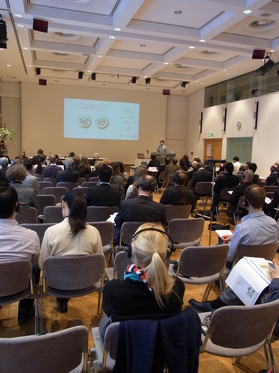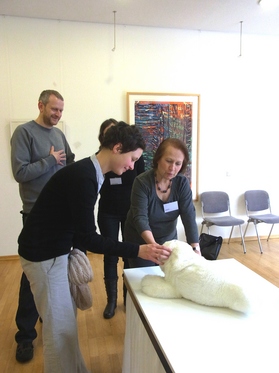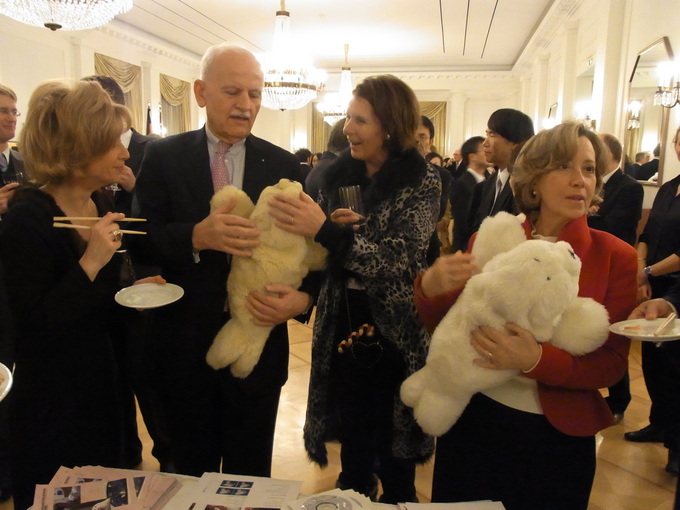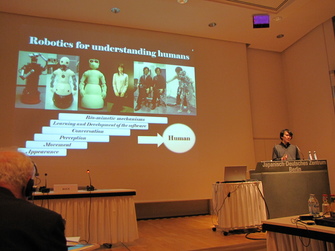Are Robots Our Friends?
Teruyo Horie Europe, Middle East and Africa Section Japanese Studies and Intellectual Exchange Dept. The Japan Foundation
On December 7 and 8, 2010, the joint symposium titled "Symposium: Human-Robot Interaction from an Intercultural Perspective: Japan and Germany" (co-hosted by the Japanese-German Center Berlin and the Japan Foundation/the Japan Cultural Institute in Cologne) was held featuring lectures and research presentations by 18 Japanese and German experts.
Speakers from diverse professions, including academics and experts in engineering, scholars of public administration and the social sciences, and religious ministers, gave presentations across a wide range of topics, from robot utilization strategies in Japan and Germany and robot development technology, to the moral and legal issues concerning robotic engineering and the therapeutic effects that can be achieved with robots.
The participants of both countries pointed out that as population aging progresses in today's society there will be a corresponding decline in the young workforce, giving rise to a growing demand for industrial and service robots. One researcher projected that the robot industry market will reach 9.7 trillion yen by the year 2035.
As the world leader in robot technology, research in Japan has stressed the importance of understanding humans as a necessary preliminary step towards creating robots capable of replacing human labor. Research is also being conducted on developing android robots which are as close as possible to real human beings.
 One of the leading scholars in this field, Professor Hiroshi Ishiguro of Osaka University, is widely known for having created Geminoid, a robot which looks exactly like him. In collaboration with playwright and stage director Oriza Hirata, he also produced the Robot Theater project, where robots "act" alongside human actors on stage. The robot play In the Heart of a Forest, which I saw at the Aichi Triennale, was performed by six humans and two robots. Although the audience was aware of the two robots, by the end of the performance the robots actually seemed to have feelings of their own.
One of the leading scholars in this field, Professor Hiroshi Ishiguro of Osaka University, is widely known for having created Geminoid, a robot which looks exactly like him. In collaboration with playwright and stage director Oriza Hirata, he also produced the Robot Theater project, where robots "act" alongside human actors on stage. The robot play In the Heart of a Forest, which I saw at the Aichi Triennale, was performed by six humans and two robots. Although the audience was aware of the two robots, by the end of the performance the robots actually seemed to have feelings of their own.
Ishiguro met Hirata in the course of his quest to create a lifelike robot, and by staging performances in which robots echo human emotions, he seeks an answer to what it is that makes nonliving robots seem to possess a soul. Ishiguro thinks this research will ultimately develop into a philosophical search for the human soul (humanity).
On the other hand, European society tends to be skeptical about the intrusion of robots into human society (as human substitutes), supposedly because of Western philosophical and religious perspectives which clearly divide "humans" from "non-humans".
Professor Graefe of Bundeswehr University Munich, introduced his HERMES robot with a body built from box-shaped units and designed to fulfill the role of a butler by answering specific questions such as "what day of the week is it?" and by serving glasses of water.
This example may be typical of the Western image of a robot as a loyal servant fulfilling only the tasks required of it. In this regard there seems to be a great contrast to the Japanese perception of desiring robots as "friends", as exemplified by the anime robot Astro Boy and the robot toy AIBO.
The seal-like therapy robot PARO, also introduced at the symposium, is a typical example of the Japanese "robot as friend" concept. PARO is used in robot-assisted therapy, a field where research has progressed at a rapid pace in recent years as a viable alternative to animal-assisted therapy.
Animal-assisted therapy has many advantages, for example, enabling patients to engage in rehabilitation without the assistance of an attendant, providing mental comfort, and shortening the duration of treatment. It has been found, however, that similar effects can be achieved using animal-type robots. In addition, there are further merits in that stress on living animals is eliminated, hygiene is easier to maintain, and health risks such as infection and allergies are prevented.
 PARO is the culmination of such research and more than 1,000 units have been sold in Japan since 2005 when it first came on the market for use in nursing homes and hospitals. It has also been sold in the United States since 2009. In Europe, its introduction into geriatric care facilities and other such institutions has begun in Denmark and other countries, providing mental support to patients of dementia in its role as a therapy robot and relieving the work load of human therapists.
PARO is the culmination of such research and more than 1,000 units have been sold in Japan since 2005 when it first came on the market for use in nursing homes and hospitals. It has also been sold in the United States since 2009. In Europe, its introduction into geriatric care facilities and other such institutions has begun in Denmark and other countries, providing mental support to patients of dementia in its role as a therapy robot and relieving the work load of human therapists.
With the acceptance of Japanese robots into welfare facilities in the United States and Europe, the Japanese perception of "robot as friend" may eventually spread throughout the world. I feel this will provide us with much food for thought from the perspective of intercultural exchange as well.
At some point in the future, robots may be used as a matter of course in everyday life, and if this happens, will those robots be human-shaped? Or will they simply look like machines?
Related Events
Back Issues
- 2025.9.30 The 51st Japan Found…
- 2025.9.30 The Japan Foundation…
- 2025.9.30 Bringing the World C…
- 2025.9.30 The 51st (2024) Japa…
- 2025.9.30 Japan Foundation Pri…
- 2024.5.24 The 50th Japan Found…
- 2024.3. 4 Movie Theaters aroun…
- 2023.4.10 The 49th Japan Found…
- 2023.3.28 JF's Initiatives for…
- 2023.1.27 Living Together with…




